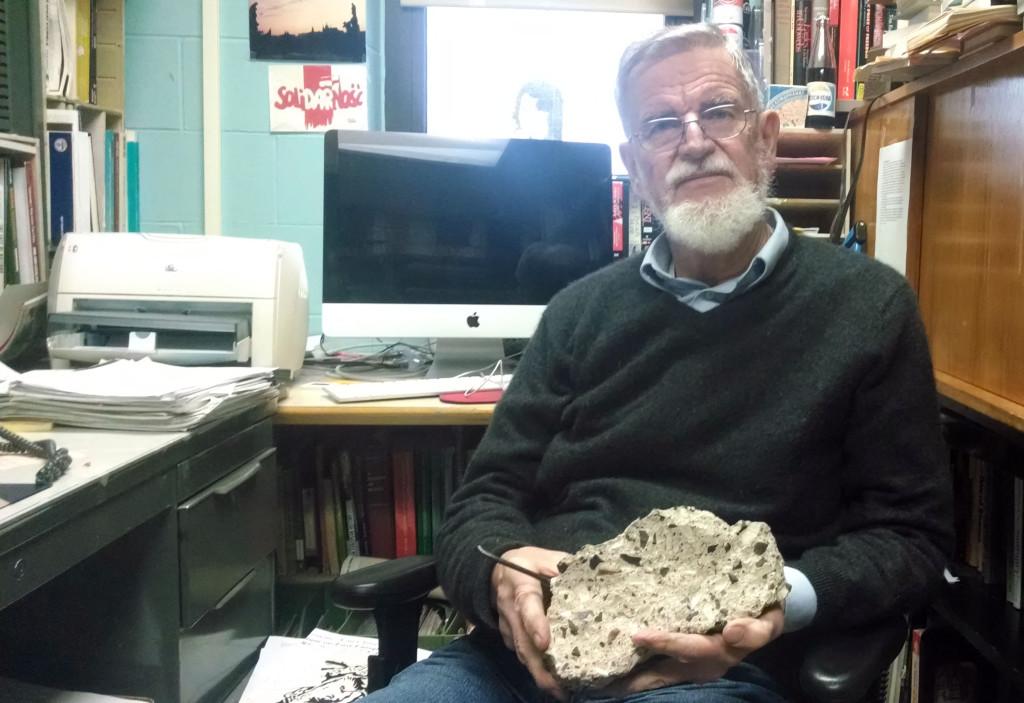Recalling the fall of the wall
UW-Eau Claire hosts discussion remembering the 25th anniversary of the Berlin Wall demolition
Photo by Nick Erickson
Paulis Lazda, professor of history at UW-Eau Claire, has a piece of the Berlin Wall in his office that he hammered out himself. He spoke at the university’s 25th anniversary discussion of the fall of the wall.
Mark Stoeger remembers a time at Eau Claire Memorial High School where he took a field trip to bomb shelter in the school’s basement.
Although it may sound lackluster compared to other high school field trips, Stoeger, vice president of the History Graduate Student Association, said it was eye opening because it was supposed to serve as protection in case the threat of nuclear war between the former Soviet Union and United States came to fruition.
One thing he distinctly remembers is the scattering of a few lemons that were supposed to be used for survival.
The threat the Soviet Union and its communist regime posed to the world was real, he said. So real, in fact, that the city of Berlin became physically divided by an almost 12-foot wall to separate the Soviet-controlled East Germany from West Germany.
“It was scary for us, but think of how scary it was for Europeans as a whole,” Stoeger said.
That wall, which was built in 1961, came down on Nov. 9, 1989, right at the height of the fall of of Soviet Russia.
Twenty five years later almost to the date, UW-Eau Claire commemorated the event.
Last Thursday, the HGSA held a discussion to talk about what the demolition of the wall meant for the world.
Paulis Lazda, professor of history and expert on the topic, highlighted the event with his own presentation, which included a video.
Lazda was born in Europe, and his parents fled the Red Army that ruled the eastern hemisphere following World War II.
He spent some time in a refugee camp before coming to the United States at the age of 12.
Beginning in 1983, Lazda annually took a group of students to Europe, and the Berlin Wall was one such destination. That is where he captured his footage for the film.
“It is a major turning point in world history,” Lazda said of the falling. “History changed from a very grim and deadly system.”
On the eastern side of the wall, Lazda said people were oppressed, and the Soviet controlled much of the daily life.
He said East Germany had a type of slave market, where people were auctioned off almost based on ability. He also said spies became prevalent and husbands and wives would sometimes spy on one another.
At one point, Lazda said there was four miles worth of files on citizens.
And, of course, the most visible form of oppression was the violence around the wall against people trying to escape.
According to Berlin.de, estimates of 136 people were killed trying to cross that wall in its nearly 28 years of existence.
“It was such an evil thing that separated families and took them from their parents,” Lazda said.
Stoeger said the event Thursday was a way for people to understand just how much oppression parts of the Soviet regime caused, and he said sometimes that can be missed in history classes.
Lazda said it’s also important for people to recognize the significance of what the Berlin Wall represented so that kind of history doesn’t repeat itself.
He said he believes even though it was just 25 years ago, we won’t see a physical divide quite like it again.
“Walls will never be built to keep people in.”











